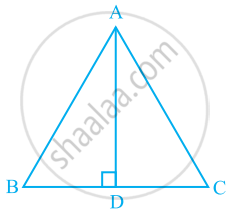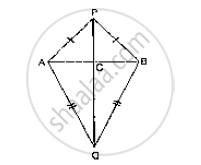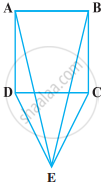Advertisements
Advertisements
प्रश्न
In ΔABC, if ∠A = 100°, AD bisects ∠A and AD ⊥ BC. Then, ∠B =
विकल्प
50°
90°
40°
100°
उत्तर
In the given ΔABC, ∠A= 100°, AD bisects ∠Aand AD ⊥ BC.
Here, we need to find ∠B.

As, AD bisects∠A,
We get,
∠BAD = ∠DAC
100 = 2∠BAD
∠BAD = 50°
Now, according to angle sum property of the triangle
In ΔABD
∠A + ∠B + ∠D = 180°
50° + ∠B + 90° = 180°
140° + ∠B = 180°
∠B = 180° - 140°
= 40°
Hence, ∠B = 40°
APPEARS IN
संबंधित प्रश्न
In ΔABC, AD is the perpendicular bisector of BC (see the given figure). Show that ΔABC is an isosceles triangle in which AB = AC.

Find the measure of each exterior angle of an equilateral triangle.
AB is a line seg P and Q are points on opposite sides of AB such that each of them is equidistant from the points A and B (See Fig. 10.26). Show that the line PQ is perpendicular bisector of AB.

Two lines AB and CD intersect at O such that BC is equal and parallel to AD. Prove that the lines AB and CD bisect at O.
In an isosceles triangle, if the vertex angle is twice the sum of the base angles, calculate the angles of the triangle.
ABC is a right angled triangle in which ∠A = 90° and AB = AC. Find ∠B and ∠C.
In ΔABC, if ∠A = 40° and ∠B = 60°. Determine the longest and shortest sides of the triangle.
Prove that the perimeter of a triangle is greater than the sum of its altitudes.
D is a point on the side BC of a ∆ABC such that AD bisects ∠BAC. Then ______.
CDE is an equilateral triangle formed on a side CD of a square ABCD (Figure). Show that ∆ADE ≅ ∆BCE.

